A high-speed train in Fushun County.
By Brian Spegele | Photographs and video by Gilles Sabrie for WSJ
Nov. 20, 2024 9:00 pm ET
On his first day in office, leader Xi Jinping inherited an ambitious road map to build 10,000 miles of high-speed rail to link China’s biggest cities. He took those plans and supersized them.
What has emerged 12 years later is one of the biggest public works in history, soon to exceed 30,000 miles of high-speed rail. For many of its citizens, the vast network is one of the clearest signs of China’s progress, especially compared with the U.S., which has struggled to get any high-speed rail going. Lest they forget whom to thank, its top-of-the-line trains are named “Rejuvenation,” after Xi’s promise to restore China’s national power.
The build-out encapsulates Xi’s vision for China’s future, with a focus on advanced technology driven by government spending. Chinese leaders once prioritized lifting individual wealth to keep people happy. Xi’s colossal investment in trains is part of a return to the Communist Party’s roots by emphasizing collective benefits from the state.
The plan sticks to a well-worn economic model built on maintaining growth through infrastructure spending—even though China already has much of what it needs.
It’s becoming a giant money pit. China has spent more than $500 billion on new tracks, trains and stations in the past five years, while the country’s national railway operator, China State Railway Group, is nearing $1 trillion of debt and other liabilities. Just keeping up with its debt requires $25 billion annually.
While passenger numbers have rebounded following the lifting of Covid-19 restrictions, raising ridership will be especially challenging in the years to come as China’s population is projected to shrink by around 200 million people in the next three decades. Some of the newest lines are in effect duplicating older ones.
The expansion now stretches into quieter corners of inland China, such as central Sichuan province’s Fushun County, where the population of 700,000 mostly rural residents has been shrinking for years. It got its first high-speed trains in 2021, and there are now at least 12 high-speed rail stations within a 40-mile radius in the county and its surrounding areas.
On a recent afternoon, Fushun Station itself was practically deserted, with around 20 travelers milling about in a cavernous waiting room with seats for 1,000.
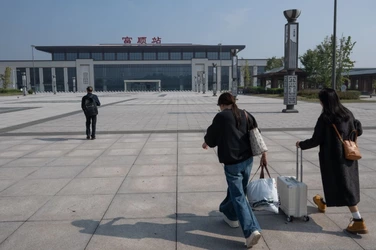
Fushun Station in October.
Another even newer station a few miles up the road was similarly empty. In the plaza outside, 50-year-old Liu Chuanfu was selling chilled rice cakes for 40 cents a bowl.
Liu roamed China for decades as a construction worker, including on a high-speed rail station in a wealthy coastal city. As the economy sagged, Liu’s pay fell 40%. He recently moved back home to Sichuan, where his expenses are cheaper.
Like many other Chinese, Liu praised the high-speed rail system overall for its convenience. Then he questioned how much more the country should build.
“We’re already saturated,” he said.
Growth story
China’s nearly 30,000 miles of high-speed rail is already more than enough to circle the globe. China State Railway envisions adding nearly 15,000 miles more by 2035, costing hundreds of billions of dollars.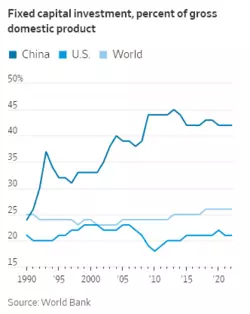
Such massive spending is a feature of China’s growth story, with investment making up about 42% of its gross domestic product, compared with 26% globally.
“If you want to get rich, first build the roads,” Xi has said to justify spending on transportation, including high-speed rail—no matter the cost.
The U.S., by contrast, has only very limited service on the East Coast that could plausibly be considered high-speed rail. A 500-mile line from Los Angeles to San Francisco under construction has grappled with costs spiraling to more than $100 billion and a still-uncertain completion date. While definitions vary, high-speed trains typically run anywhere from 125 to more than 220 miles an hour.
The challenge for China is that high-speed trains are far more costly than alternatives, such as traditional trains or buses, which many economists believe are sufficient for much of the country.
High-speed rail makes the most financial sense in densely populated areas where travelers will pay a premium to reach their destination more quickly.
The line connecting Shanghai and the tech hub of Hangzhou, home to Alibaba, drew an average of around 100,000 passenger trips every day during its first decade between 2010 and 2020, according to state media.
A similarly sized section running through Fushun County has reported only about 9,000 daily trips on average since opening in 2021, though that included a period until late 2022 when China was under strict Covid-19 controls.

All told, China State Railway’s liabilities grew to a record of about $860 billion as of September. The total debt tied to China’s rail expansion is even higher, since cash-strapped local governments are being required to bear many of the costs for new projects. Over time, maintenance costs will add up.
There’s little risk the railway operator will default, given its strong backing by China’s government. And proponents of China’s build-out say the fast trains create positive knock-on effects, such as cutting pollution from gas-powered cars, shortening travel times for business trips and promoting urbanization.
Yet as the government pursues trophy projects that symbolize its status as a leading power, at the individual level, many citizens are feeling poorer and their futures less secure. The rail investments also divert resources away from initiatives such as building a stronger social safety net that economists say China needs to help its aging population and increase domestic consumption over time.
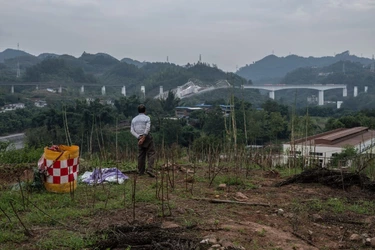
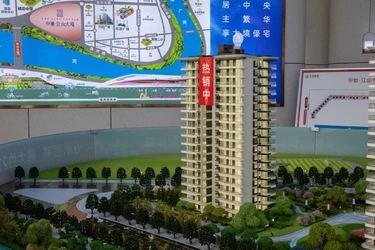
A construction site for a new high-speed rail line in Gao County, seen from across the river. A showroom promotes a real-estate project along the line.
Zhao Jian, a scholar at Beijing Jiaotong University who’s critical of the high-speed rail build-out, has argued in commentaries that China is turning a blind eye to the system’s financial perils. He has said the country would have been better off only building a few thousand miles of high-speed rail in its most densely populated areas. Hundreds of billions of dollars could have instead been invested in traditional railways that can also handle freight, as well as on more research in areas like advanced chips.
Spending on trains could also come at the expense of efforts to lift economic opportunities for Chinese people over the long run, with hundreds of millions of people across the country lacking in education.
“Just do the cost-benefit analysis,” said Scott Rozelle, a Stanford University economist who studies Chinese development.
Such efforts take years to bear fruit, while building trains offers an immediate boost to an economy that has struggled to keep people employed, economists said.

State media focuses on new trains as feats of Chinese engineering that create well-paying jobs. At work sites as high as 14,000 feet above sea level, one of China’s priciest rail projects is taking shape, linking Tibet’s capital of Lhasa with the central city of Chengdu in Sichuan, at a cost of more than $50 billion.
“Our village has over 30 people working for their rice at the railways,” a janitor at one station in Tibet along the new line told state media.
While not technically high-speed rail, the trains would run at around 100 miles an hour over the 13-hour journey. That’s still far longer than the 2½ hours it takes to fly from Chengdu to Lhasa, with plentiful daily options. Flights can go for as little as $50 one way, making it tough for the trains to compete.
Cheap seats
China says it can make its railways more economically viable. Over the past decade, Beijing pursued a series of reforms to make its railroads operate more like businesses, abolishing the government departments that had long run the nation’s trains and then launching China State Railway in 2019.A drive to slash overhead helped China State Railway turn a roughly $460 million profit last year after losing close to $25 billion from 2020 to 2022 during the pandemic. Its results last year were boosted by more than $1 billion in “other income,” a line item in China that typically includes state subsidies.
Some of its two dozen major operating units are facing serious difficulties. Its biggest subsidiary, based in Sichuan, lost $1 billion in 2023 as it expanded in rural areas and smaller cities inland.
China State Railway and the Ministry of Finance didn’t respond to requests for comment. The company’s chief accountant has previously said that it takes its debt issues seriously and that the financial risks are manageable, highlighting the quality of its assets.


Passengers at the Chengdu East Railway Station. An attendant sold food on a train from Kunming.
Efforts to boost profitability are constrained by a desire to keep ticket prices low, which builds goodwill for Xi and the government. A study by Chinese academics last year found that prices for high-speed rail tickets in China were less than a quarter of the average cost of such tickets globally.
The trains have become a point of national pride for many people, including Zhang Jianbo, who emerged from Fushun Station on a recent morning after a business trip with his wife to Chengdu. Had he driven, his $13 ticket for the trip of over 130 miles wouldn’t have covered the highway tolls, let alone pay for gas.
Many Chinese resist higher ticket prices, viewing the network as a public service. When China State Railway announced price hikes of as much as 20% for a few lines earlier this year, a torrent of online criticism followed.
Altogether last year, travelers took 3.7 billion trips on the nation’s railways, including both high-speed and traditional slower trains.
Zhao, the Beijing-based scholar, has said many lines in China were running fewer than 16 pairs of trains daily in both directions, a fraction of their capacities. While China State Railway reported ridership growth of 18% in the first half of 2024 compared with a year earlier amid a domestic tourism boom, its operating revenues were practically flat over the same period.
Double routes
The early build-out of high-speed rail, under Xi’s predecessor Hu Jintao, sought to link China’s biggest and richest cities, using technologies imported from Japan and Europe.The Beijing-to-Shanghai route, opened in 2011, has thrived. A listed unit of China State Railway running service between the cities had profits of more than $1.5 billion last year.
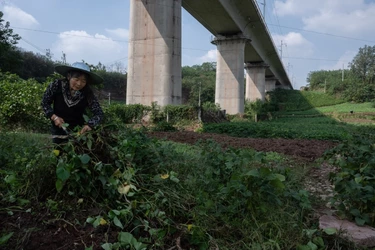

Farmers harvested sweet potatoes and dried rice below the tracks of a high-speed rail line in Fushun County.
China is now practically duplicating some routes. High-speed trains have operated for years between the inland cities of Chongqing and Kunming, a journey that takes about five hours. China State Railway says a new $20 billion line being built between the cities, following a different path, will cut travel time to about two hours, while supporting the regional economy and promoting national unity.
That route will soon bring high-speed trains to Sichuan’s Gao County, south of Fushun, for the first time. In the county seat, property developers are erecting new apartment blocks in a district that will be home to its high-speed rail station.
Gao County’s population of about 375,000, including many pig farmers and grain growers, has shrunk nearly 10% since 2019 as locals sought work elsewhere. Per capita economic output is two-thirds of the national level.
The area doesn’t lack connectivity. High-speed trains run through the city of Yibin, 40 minutes north. The 20 million-person metropolis of Chengdu is reachable in about two hours.
The bigger issue for Gao County, and the residents of its 200 villages, is a lack of jobs.
“If you’re hardworking and want to make more money, you’ve got to find work on the outside,” said one villager whose home and plot of farmland sits in the shadow of the new line’s elevated tracks. She said officials promised her the trains that will soon zip by won’t be too noisy.
In nearby Luojia Village, the line’s construction has hastened the community’s decline, residents said, as the government requisitioned land for tracks and for another infrastructure project upgrading the local waterworks.
“More and more people have gone elsewhere,” said 62-year-old Hu Mingqun, who runs a village health center with her husband. “Those who stay at home to farm don’t make much money because their land has shrunk.”
Still, Hu said she enjoyed taking the high-speed rail to visit her daughter in another province, and trusted that the system would ultimately make life in China better.
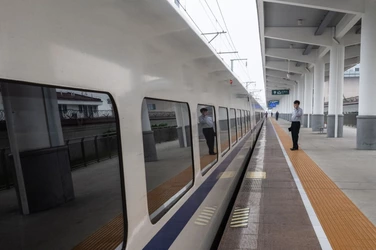
A high-speed train on the line between Yibin and Chengdu.
-Zhao Yueling contributed to this article.
Source (Archive)